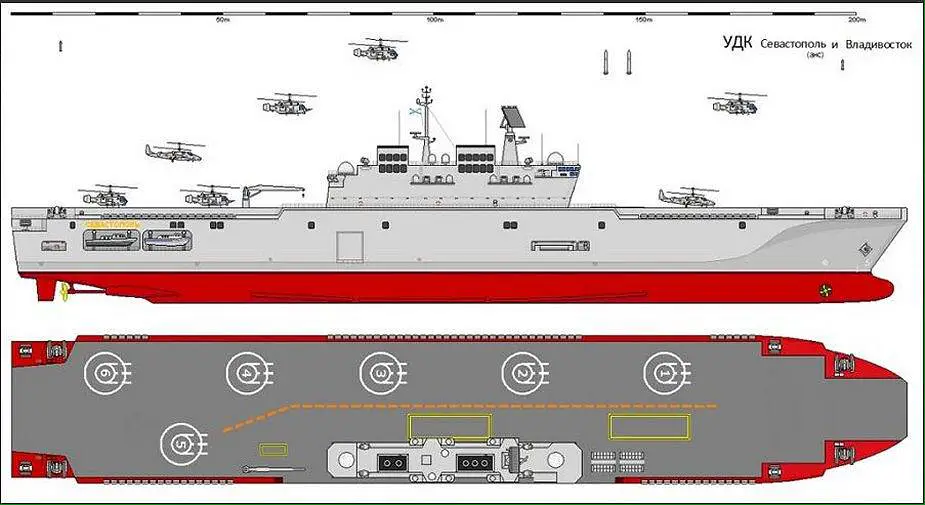Analysis Part 1: Russian Navy starts production of amphibious assault ships Project 23900
Zvezda Shipyard in Kerch will lay two new warships shortly. The universal landing ships (UDK) of project 23900 have to join the Navy by the end of 2027 and are the most expected ships in the past fifty years of the Russian Navy. The Profile magazine writes about the development of Russian amphibious assault forces.
Follow Navy Recognition on Google News at this link
 Model of the proposed "Priboy" amphibious assault ship at the «ARMY-2015» military-technical forum. (Picture source By Artem Tkachenko Wikipedia)
Model of the proposed "Priboy" amphibious assault ship at the «ARMY-2015» military-technical forum. (Picture source By Artem Tkachenko Wikipedia)
The Russian concept of the engagement of amphibious assault has been until recently based on the experience of two world wars. The main provisions say: 1. the amphibious assault supports the ground forces in coastal operations, 2. the scope of the assault is determined by, firstly, the needs of the army in coastal support, secondly, the range of coastal aviation which has to protect the assault, thirdly, the ability of the fleet to accompany the assault and provide fire support, 3. the scope of operations by marines is not big and limited by the tactical level (up to a brigade). If necessary, reinforcements are provided by ground forces. They are delivered by ordinary ships to the seaports seized by the first echelon. Airborne Forces can also be used as reinforcements.
The concept did not change for a long time and affected the composition of the Navy. The first post-war landing ships of the Soviet Navy (small landing ships of project 450 and their successors built in the early 1950s) had to land an assault from a ramp. Conceptually, they copied British Landing Craft Tank of World War Two. It was a generally sufficient force.
The elimination of Soviet marines in 1956-1963 affected the evolution of the landing forces. The assault had to be provided only by the ground forces while landing ships were mostly used as transportation vessels.
The marines began to revive in 1963 after a series of incidents caused by poor readiness of ground units for amphibious assault. The construction of middle and big landing ships began. Conceptually, they copied US Landing Ship Tank (LST) and were designed to land the assault on the coast.
In the meantime, the West began to revise the engagement concept of marines because of considerable restrictions in traditional landing methods. Only several percent of the global coastline were fit for them. Besides, a landing ship at the coast is an ideal target for artillery and aviation.

Drawing of Project 23900 amphibious landing ship for the Russian Navy. (Picture source Twitter)
Landing Ship Docks (LSD) partially resolved the problem. The docks carried the assault and the landing boats. The warship could stay outside the zone of hostile fire. Its landing boats were more complicated and less valuable targets. The share of appropriate coastline exceeded 15 percent.
The next stage produced Landing Platform Dock (LPD) with a helicopter hangar, as well as Landing Platform Helicopters (LPH) rebuilt from outdated WW2 aircraft carriers and specialized Ivo Jima. The latter had a classical aircraft-carrying architecture with a cut-through flight deck and starboard superstructure. They had a more powerful helicopter assault force than LPD. Both ships had to be engaged in a large-scale amphibious assault. However, it was necessary to coordinate the units landing from various ships under the command of various headquarters.
LPD and LPH merged into a hybrid with a flight deck and a dock. The first universal landing ship was the Tarawa-class Landing Helicopter Assault (LHA-1) which became operational in the US Navy in 1976.
The US Navy thus obtained full-fledged expeditionary forces capable of operating heavy hardware and aviation at any distance from the base. The emergence of Wasp-class ships provided additional capabilities as they carried air-cushioned landing boats. Together with helicopters they increased the accessible coastline to 70 percent and accelerated the landing operation.
The air-cushioned landing boats allow a universal landing ship to stay behind the horizon and land a marine battalion with heavy hardware and artillery in half an hour on hard-of-access coast with dangerous banks and soft beaches. Besides landing helicopter gunships, the airpower includes vertical takeoff jets for expanded support to the landed force.
© Copyright 2020 TASS Navy Recognition. All rights reserved. This material may not be published, broadcast, rewritten or redistributed.


























